THE LUNA ROSSA STORY: SAILING INTO HISTORY
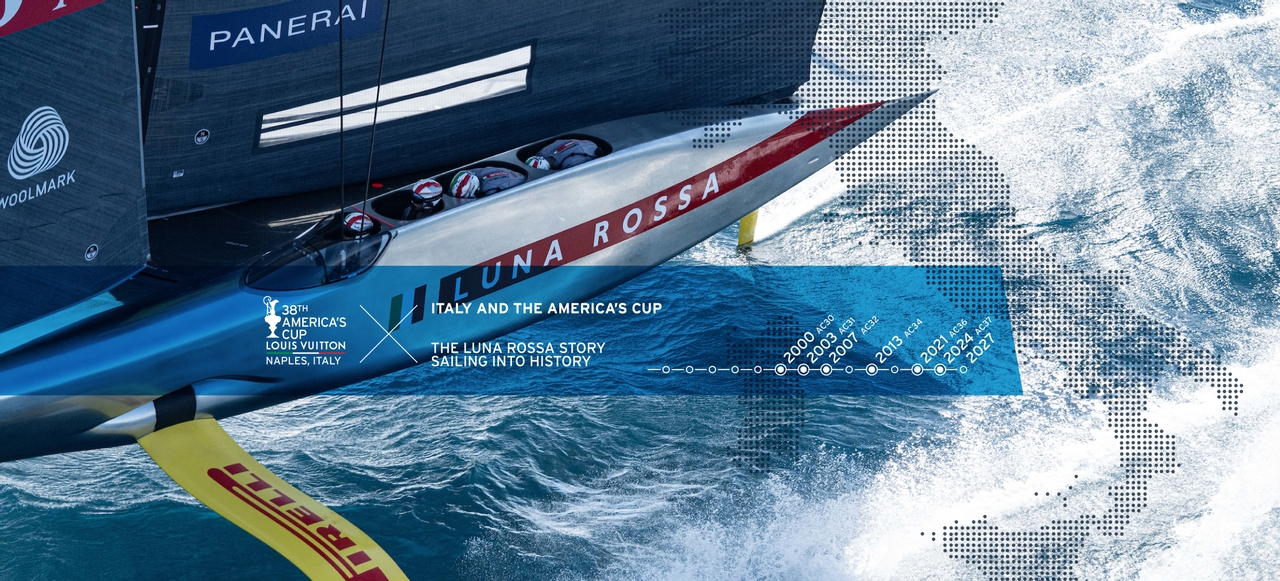
When Patrizio Bertelli sat down in the Milan studio of naval architect German Frers to discuss the lines of a new fast-cruiser in early 1997, the Argentinian proclaimed that all the pieces were in place to mount a challenge for the America’s Cup. Bertelli was convinced, and as a prominent businessman had steered the Prada name to the very top of global fashion, he was a master at organisational strategy and quickly put in place the building blocks to success. Francesco de Angelis from Naples, and Torben Grael, the five-time Olympic medallist from Brazil were the cornerstones of the initial team, whilst Doug Petersen was brought in as lead designer.
RELIVE THE LUNA ROSSA STORY
Francesco de Angelis, the Admiral’s Cup winner and J24 World Champion, was excited by the new venture saying: “For us, Prada Challenge – Luna Rossa – was the start of something new, an all-Italian team, standing on the shoulders of the Italian campaigns that had come before us: Azzurra, Italia, and Il Moro di Venezia. We were combining the experiences and talents of all of the previous Italian efforts, and this felt like our best chance yet.”
Joining the crew for the first challenge which would be in Auckland in early 2000 was Matteo Plazzi as navigator and a young Max Sirena as mid-bowman, two figures that would play significant roles over the coming 25 years through to the present day. Sirena had first met Bertelli in 1993 when he was trialling for a position on the owner’s classic 1938-built, Olin Stephens designed 12 Metre yacht Nyala. An often-repeated quote from their first meeting: “My first meeting with Bertelli is now famous. In 1993 I was called to do training on his Nyala at Argentario, I knew Bertelli’s name but had never met him, I didn’t know what he looked like. On the way back to port I could hear this loud voice on the dock, and I said to this gentleman, what are you yelling about? He said: who are you? I answered, I am Max Sirena. He replied, I’m Patrizio Bertelli, give me five minutes to figure out if I’m going to blow you off right now or if we’ll see each other again.” Today Max Sirena is the CEO of Luna Rossa.
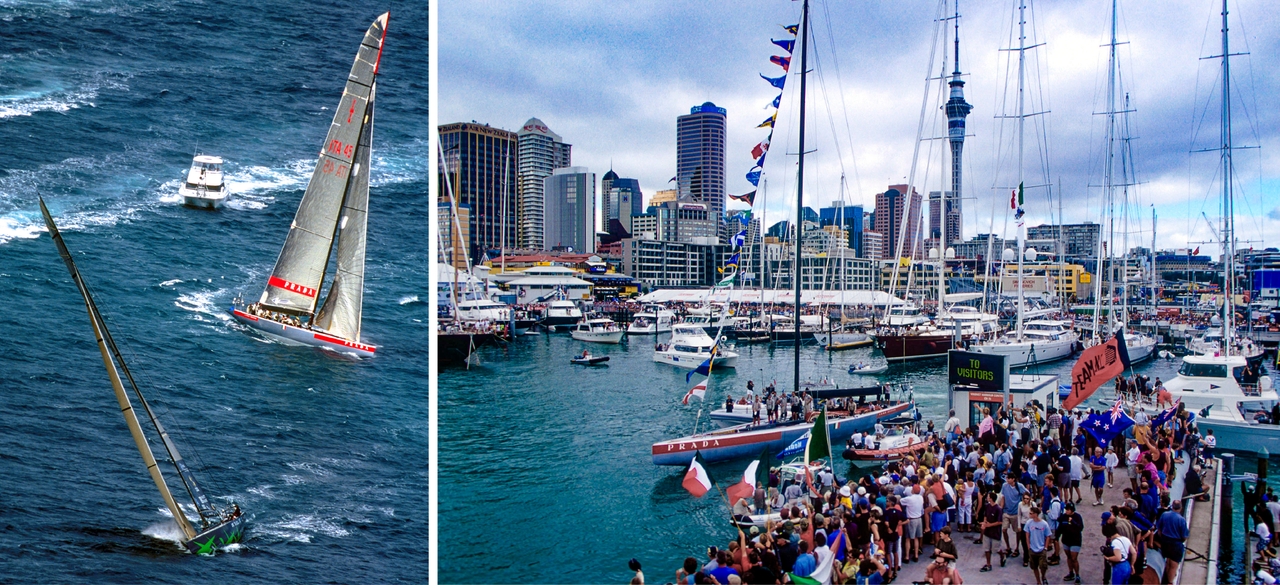
LEFT Prada Challenge (ITA) sailed against AmericaOne (USA) in one of the most hotly contested Louis Vuitton Cup Finals ever in 2000. Prada Challenge won by 5-4 and advanced to the 30th America’s Cup Match to face Team New Zealand. | RIGHT Prada Challenge celebrate their victory in the Louis Vuitton Cup of 2000 at the downtown Auckland Viaduct. Photos: © Carlo Borlenghi.
The first America’s Cup regatta was sensational for Luna Rossa. Challenging under the burgee of the Punta Ala Yacht Club in Tuscany, Bertelli had acquired the IACC yachts of Bill Koch including Mighty Mary, Kanza and America3 as training vessels and then built two new boats for the Cup ITA-45 and ITA-48. Starting in early October 1999, Luna Rossa immediately showed speed, sailing the newer boat but knowing that their first boat was a strong contender for the later rounds. Ranged against them were the outstanding team of AmericaOne, led by Paul Cayard who had done so much for Italian sailing, taking the Il Moro di Venezia challenge to success in the Louis Vuitton Cup in 1992.
The first hurdle was to qualify for the America’s Cup Match, no easy feat. Prada Challenge were one of eleven Challengers from seven nations vying for the Louis Vuitton Cup, the winner of which would move forward to face the Defender, Team New Zealand, for the America’s Cup. Remarkably, in their America’s Cup debut, Prada Challenge breezed into the Finals and faced down Cayard in some of the most memorable action ever seen on an America’s Cup racecourse. It was aggressive match-racing, but the Italians came through with Paul Cayard remembering the combativeness of one famous race where the two boats were sailing downwind clearly: “The reason for the aggressivity there on our part was to make sure they didn't sail down across our bow and there was a lot of gamesmanship there too. The umpires are humans, and they are influenced by everything from your previous track record to actually what's going on in the instant. No fault. It's just humans. And so, you're using everything you have to succeed in that moment. And as I said, I always, in those days, felt I had the advantage in match-racing. Torben [Grael] is a brilliant sailor. He won way more gold medals than I did in the Olympics, but we were in a match race in 25-ton boats, and I was giving no quarter.”
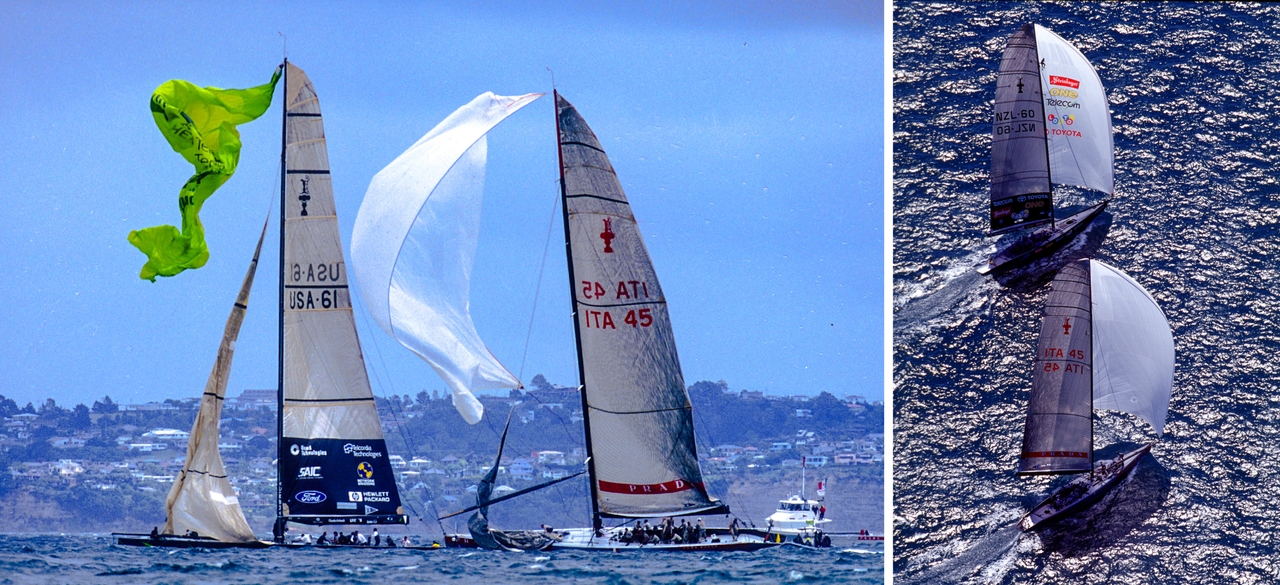
LEFT Prada Challenge putting extreme pressure on AmericaOne, luffing from leeward as the American team tore their spinnaker during the Louis Vuitton Cup in Auckland, 2000. | RIGHT Prada Challenge faced Team New Zealand for the 30th America’s Cup in Auckland. It was Italy's second time in the America's Cup Match, but the Kiwis were victorious winning 5-0 in what became known as a ‘blackwash.’ Photos: © Carlo Borlenghi.
Luna Rossa went on to win the Louis Vuitton Cup for the second time in the country’s history and advanced to the 30th America’s Cup Match only to face the awesome firepower of the Royal New Zealand Yacht Squadron’s syndicate, Team New Zealand. It was a one-sided Final that saw the Kiwis, under the leadership of Sir Peter Blake, win with a 5-0 scoreline. Patrizio Bertelli vowed to challenge again and was indeed the first challenge received when entries opened.
The 2003 America’s Cup saw Francesco de Angelis back as skipper and a familiar continuity team that also introduced three-time Olympian Francesco Bruni as helmsman, whilst on the grinding pedestals came Gilberto Nobili who today is Chief Technology Officer and Chief Operating Officer of Luna Rossa. Matteo Plazzi was again navigator and Torben Grael as tactician. The 2003 campaign was led by Laurent Esquier (as he did in 2000 as well) in his tenth America’s Cup and the budget was reportedly $85 million serving a staff of some 130 people. Every avenue was exploited in their quest to improve on the 2000 ‘blackwash’ with Rod Davis and Gavin Brady brought in as sparring partners and the purchase of the two Bruce Farr designed yachts of Young America that competed in the 2000 Cup. German and Mani Frers had left the design team, so in came Ian Howlett from the UK and Juan Kouyoumdjian from Argentina.
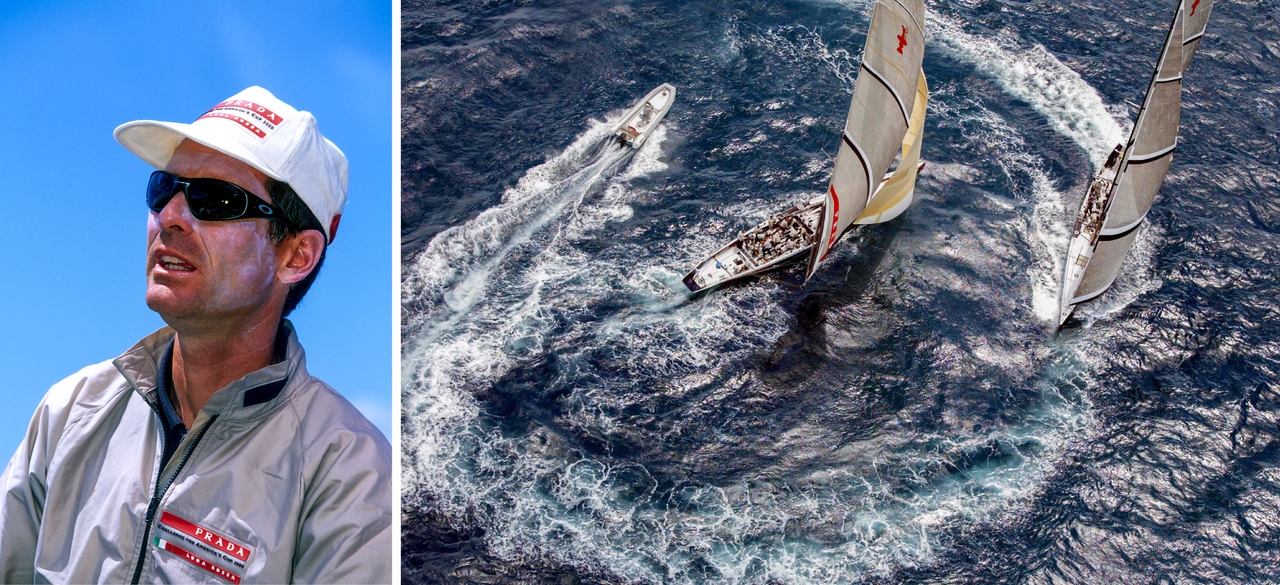
LEFT Francesco de Angelis, the mercurial skipper and multiple big boat champion led Luna Rossa’s challenges in both 2000 and 2003. | RIGHT Luna Rossa left no stone unturned in 2003 and, having acquired the boats of the 2000 Young America (USA) team, trained hard against the likes of Gavin Brady and Rod Davis. Pictured here is typical aggressive circling during training starts in Auckland, New Zealand. Photos: © Carlo Borlenghi.
However, as the 2003 Cup unfolded, tensions grew within the team with Bertelli getting frustrated with Doug Peterson, as they had the only boats not to have the ‘stepped bow’ that were ubiquitous. As a last move to research for speed the two boats ITA74 and ITA 80 were modified to implement this design feature. Results though were tough to come by, and it was a scrap through the Semi-Final repechage with the OneWorld syndicate of Craig McCaw that eventually saw the Italians eliminated, whilst the America’s Cup was taken to Europe by the Société Nautique de Genève for the first time in its history.

Again, the re-named Luna Rossa Challenge was the first to set up a base in Valencia, designed by famous architect Renzo Piano, when the venue was announced, but critical changes were being made by Patrizio Bertelli both structurally and in terms of personnel. In came the mercurial Jimmy Spithill who had impressed Francesco de Angelis in the way that he had aggressively dismantled the Oracle BMW Racing team in the Semi-Finals of the Louis Vuitton Cup in 2000 – so much so that the skipper of the American boat resigned two days later. There was a racing edge to the Italian team in Valencia who challenged under the burgee of the Yacht Club Italiano of Genoa and secured backing from Telecom Italia.
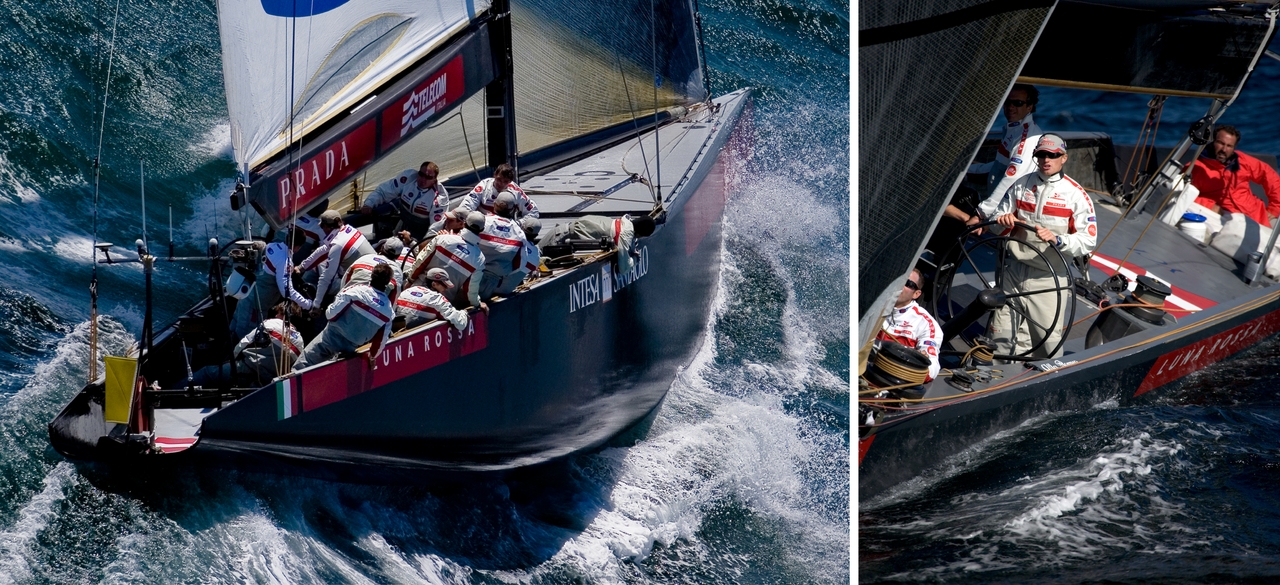
LEFT Valencia, Spain: Luna Rossa sailing through dynamic waters during the second Round Robin of the Louis Vuitton Cup in 2007. | RIGHT James "Jimmy" Spithill at the helm of the IACC Luna Rossa in the lead-up to the 32nd America's Cup in Valencia, Spain in 2007. Photos: © Carlo Borlenghi.
Luna Rossa tuned up their two race boats ITA-86 and ITA-94, with the latter being selected for the Louis Vuitton Cup where they advanced to the Semi-Finals and defeated Oracle BMW Racing 5-1 only to meet their nemesis in the form of a re-vitalised Emirates Team New Zealand, in the final. Once again it was a Kiwi victory by a considerable margin with the Italians dispatched 5-0 on their way to contest the America’s Cup Match.
Post the 2007 regatta, the America’s Cup went into a hiatus with the Deed of Gift Match being contested between BMW Oracle Racing and Alinghi in 2010 which set the America’s Cup back many years and lost most teams. Meanwhile, the Luna Rossa team remained fully active and engaged in numerous sporting and racing activities, with the goal of maintaining a consistently high-performance level and strong commitment from its team members. In 2009, the STP65 was launched, and the team went on to compete in the Rolex Fastnet Race, the Middle Sea Race, and the Maxi World Championship. It also took part in the Louis Vuitton Trophy events in Auckland in 2009 and La Maddalena in 2010. That same year, under the leadership of Max Sirena as head of the sporting project, Luna Rossa participated in the MedCup with the TP52. In 2011, the team celebrated a major success by winning the Extreme Sailing Series.
When the next America’s Cup was announced for San Francisco in 2013, Luna Rossa were the last Challenger to enter in October 2011, doing so under the burgee of the Circolo della Vela Sicilia. Leading the team for the San Francisco edition was Max Sirena, who, in the previous Cup, had competed and won with the American team as wing-mast technician.
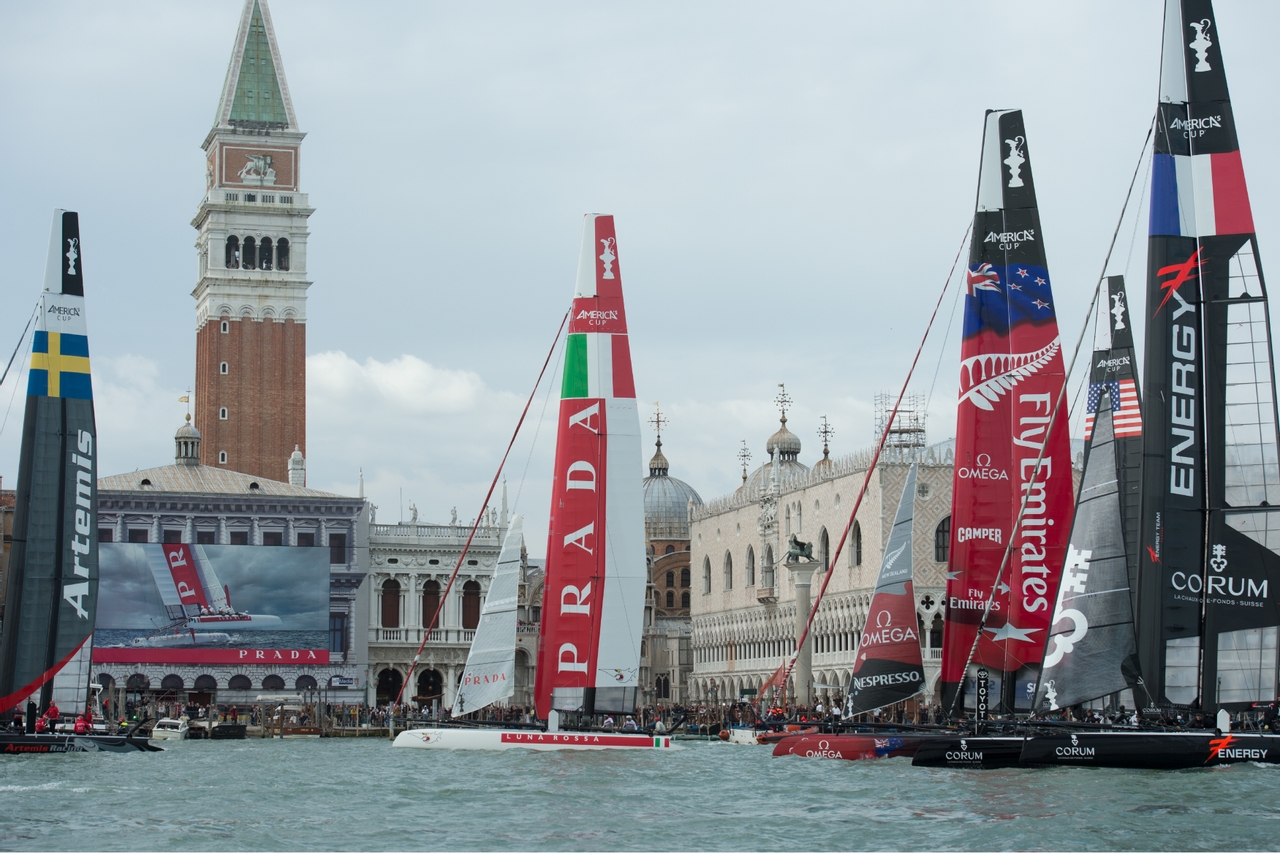
Sailing past the stunning cityscape of Venice, Italy, the teams put on a spectacular show during the Arzana’s Trophy – a vibrant prelude to the 34th America’s Cup. Photo: © Emirates Team New Zealand.
The team built two AC45 catamarans that they named Piranha and Swordfish and hired British talent Paul Campbell-James and Chris Draper to steer the boats with Francesco Bruni and Max Sirena onboard doing wing trim. Other notable team members included Pierluigi de Felice (trimmer), Simone de Mari (primary grinder), Xabi Fernández (wing trimmer), Nick Hutton (bowman), Lele Marino (wing grinder), Marco Montis (freestyler), and Wade Morgan (hydraulic grinder). Success came, and as the America’s Cup brought in a new global series of regattas, with the first being a memorable event in Naples, the Italians were eventually crowned as the winners of the 2012/2013 America’s Cup World Series after a controversial penalisation of the Oracle Team USA team for illegally modifying their one design catamarans.
Luna Rossa built just one AC72 catamaran with design influence from Emirates Team New Zealand and put on a good performance in San Francisco routing the Swedish Artemis Challenge in the Semi-Finals that was recovering from a fatal capsize that saw the loss of British sailor Andrew Simpson earlier in training. Luna Rossa advanced to the Final but lost 7-1 to the Kiwis. The America’s Cup was retained by the Americans who then declared that a new class of catamaran would be developed, the AC62, and Luna Rossa set to work immediately in Cagliari on the design.
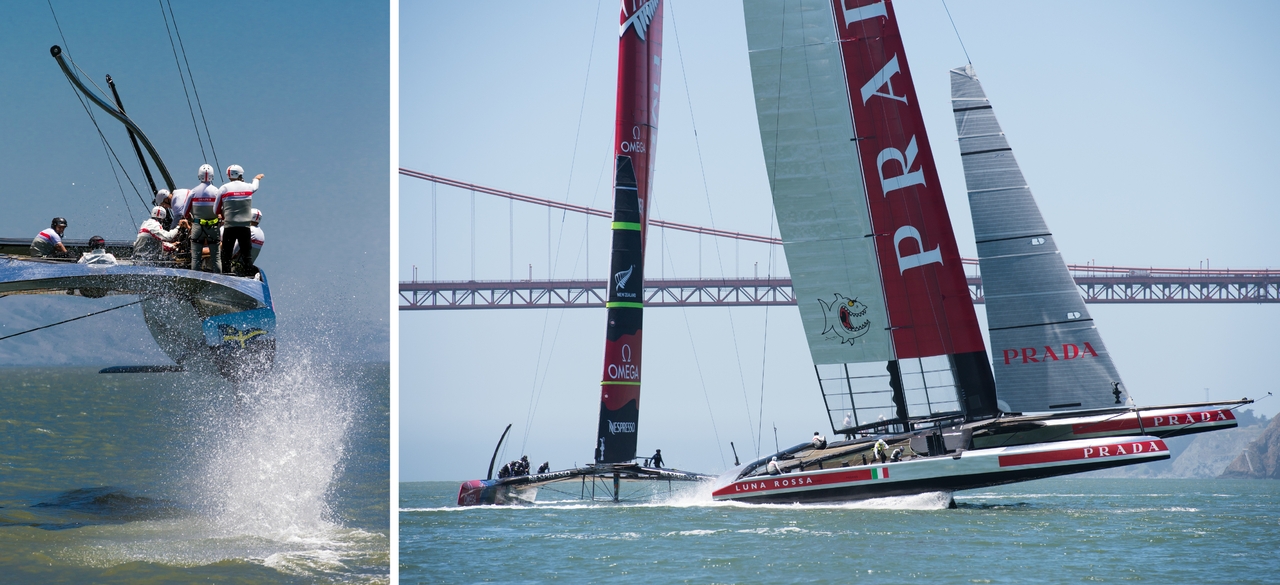
LEFT British sailor Chris Draper helming the 2013 Luna Rossa AC72 in San Francisco Bay with Francesco Bruni calling the tactical shots from behind. Photo: © Carlo Borlenghi. | RIGHT The Luna Rossa AC72 catamaran was one of the most striking boats of the 2013 America’s Cup that was held in San Francisco Bay, representing the Circolo della Vela Sicilia. Here they are sailing theirtheir second practice race against NZL5. Photo: © Emirates Team New Zealand.
However, in 2015 just ahead of the start of the America’s Cup World Series, the Defenders Oracle Team USA, declared that it was their intention to switch designs to the smaller AC50 catamaran class and in protest at the decision, Luna Rossa withdrew from the competition. The Italians lent key personnel and design information to Emirates Team New Zealand who would go on to win the Cup in Bermuda in 2017 and end the American stranglehold on the Cup.
With the Cup now in the hands of the Royal New Zealand Yacht Squadron, Luna Rossa was accepted as Challenger of Record for the 36th America’s Cup. With cost-reductions in mind, the new AC75 foiling monohull was launched. Luna Rossa developed their innovative boat in Cagliari that featured dual helms at a time when others swapped sides. Jimmy Spithill came back to the team, and when his appointment was announced he said: “It's great to be back with Luna Rossa Challenge – I have a lot of great memories from the four years we spent in Valencia during the 32nd America’s Cup, and this time I have been impressed with the tools, technology and people they have in place. It's a great mix of experience, new energy and enthusiasm in an open environment – the makings of a great team. The boat is going to be a beast. It reminds me of the 34th America's Cup and the AC72 foiling catamarans. Nothing like this had been done before, and this boat is on the cutting edge of technology. There are a lot of unknowns with the AC75, which will push people to the limit and really challenge all the teams involved. However, this challenge and difficulty is really appealing, and I'm really excited to be back in the game.”
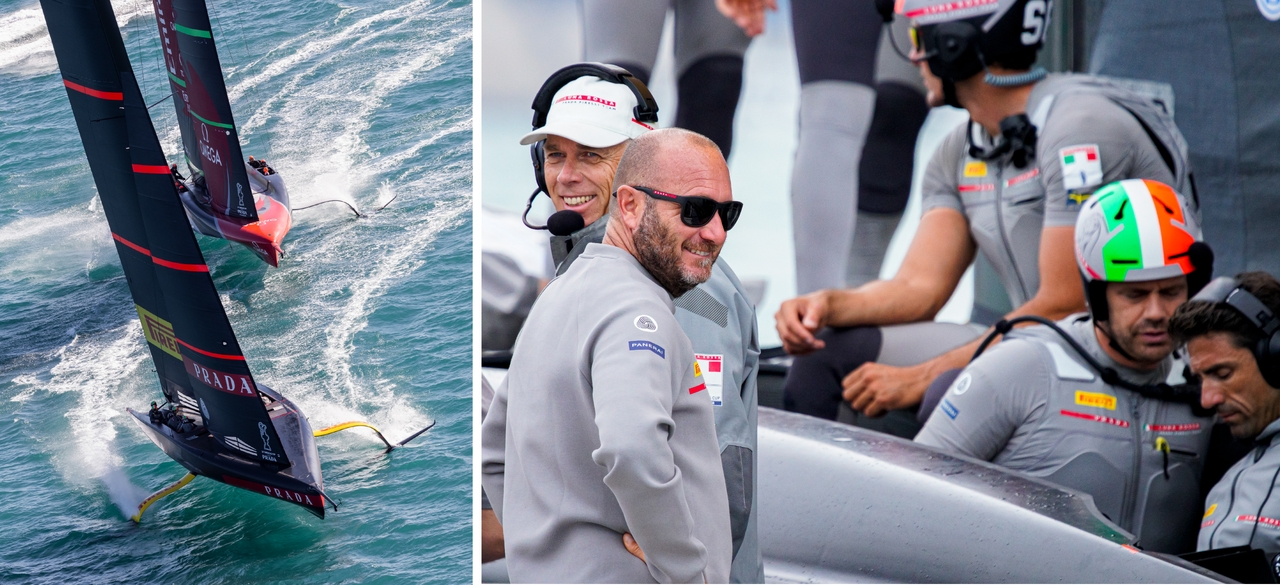
LEFT A practice race between Luna Rossa Prada Pirelli Team and Emirates Team New Zealand ahead of the 36th America's Cup in Auckland, New Zealand in 2021. | RIGHT Max Sirena (Team Director & Skipper of Luna Rossa Prada Pirelli Team; front) and coach Philippe Presti inbetween races of the 36th America's Cup. Photos: © COR 36 | Studio Borlenghi.
With sponsorship coming in from Pirelli, the new Luna Rossa Prada Pirelli team for the 2021 America's Cup included Team Director and Skipper Max Sirena, co-helmsman Francesco Bruni and a crew of sailors including Pietro Sibello, Vasco Vascotto, and Shannon Falcone. It was a remarkable campaign, but the global pandemic made participation and sponsorship for teams hard. American Magic, representing the New York Yacht Club and INEOS Team UK representing the Royal Yacht Squadron Ltd. were the hurdles that Luna Rossa overcame in the Prada Cup Challenger Selection Series, advancing to the America’s Cup Match to face the Defender Emirates Team New Zealand.
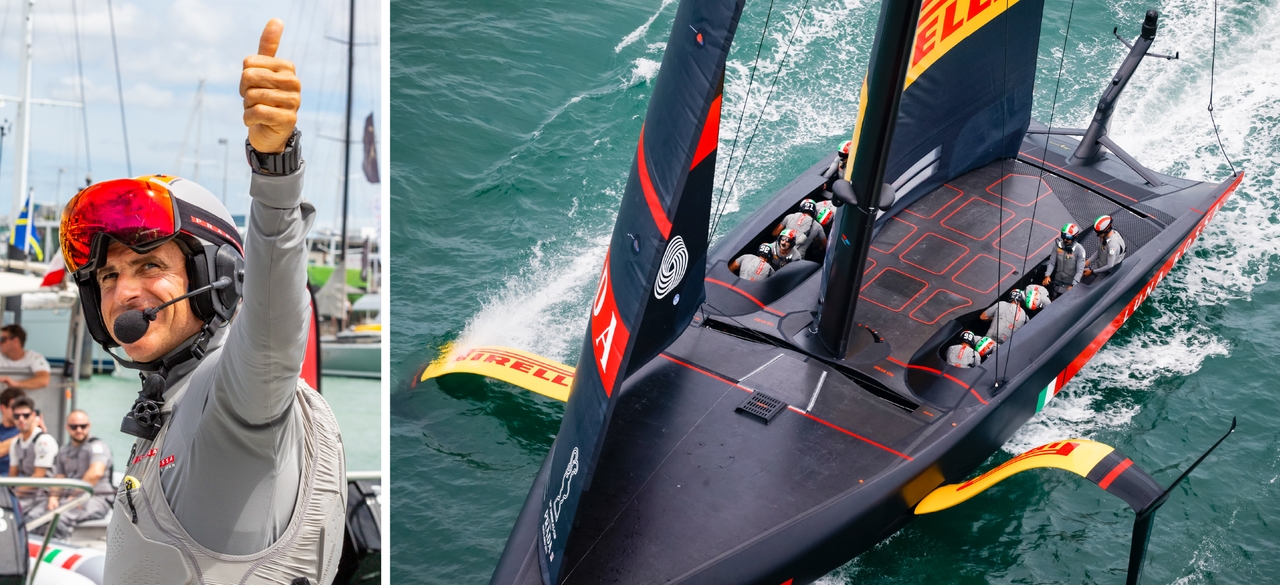
LEFT Francesco Bruni greets a wave of passionate Italian supporters in Auckland as he co-helms Luna Rossa Prada Pirelli together with Jimmy Spithill. | RIGHT During the 36th America's Cup, the Italian team were the first to implement dual driving pods meaning the helming was shared and the sailors did not have to cross the boat after every manoeuvre. Photos: © COR 36 | Studio Borlenghi.
In light conditions, and with superb boat handling, Luna Rossa took three races off the Defender and set Italian fans wild back home with the scoreline at 3-3. However, the Kiwis clicked into another gear and won four straight races to retain the Cup. Luna Rossa’s long-time adversary had won again but there was little hesitation in the team preparing for the Louis Vuitton 37th America’s Cup in Barcelona in 2024.
Training out of Cagliari at their impressive facility downtown, Luna Rossa created a stunning test-boat, an LEQ12, to test foil designs and crew. Once again Jimmy Spithill and Francesco Bruni were appointed as co-helms, but the team also brought in the young Italian talent of Marco Gradoni and Olympic double gold medallist, Ruggero Tita. At the launch in Cagliari, Miuccia Prada cracked the customary champagne bottle on the bowsprit and the Italians were heavily tipped to go deep in the competition.

Luna Rossa developed the most striking test boat, an LEQ12, for the lead-up to the Louis Vuitton 37th America’s Cup that they used to test foils and sail packages. Training out of their base at the Molo Icnusa in Cagliari, the test boat programme was noted for its increasing intensity as it informed the design of the team’s AC75 for Barcelona. Photos: © Ivo Rovira / America's Cup.
From the start they were the front runners of the Challengers and very much seen as the team to beat. However, the British boat INEOS Britannia worked through an extensive development programme under the guidance of Mercedes Applied Science and pipped Luna Rossa Prada Pirelli at the top of the standings going into the Semi-Finals. Luna Rossa faced American Magic, whilst the British selected Alinghi Red Bull Racing, and had a close battle with Tom Slingsby’s team and suffered boat damage when the track of the mainsheet pulled off. The team recovered, winning the Semi-Final and eventually facing INEOS Britannia for the Louis Vuitton Cup.
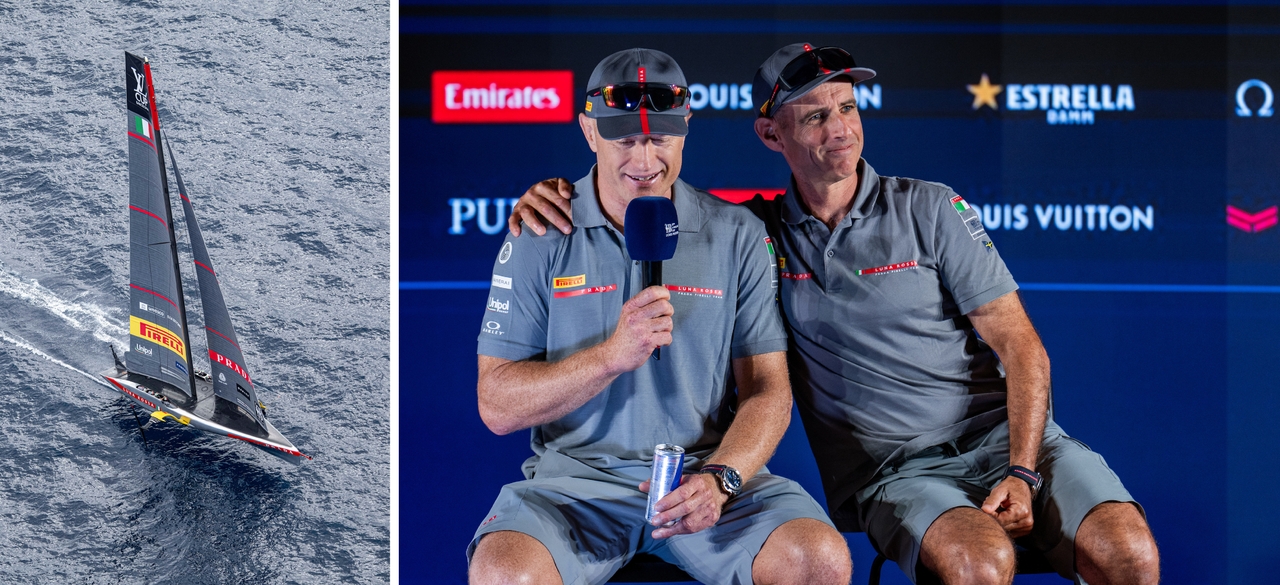
LEFT For the Louis Vuitton 37th America's Cup in Barcelona, 2024, Luna Rossa Prada Pirelli were back in their sleek silver bullet design. Photo: @ Ricardo Pinto / America's Cup. | RIGHT Jimmy Spithill and Francesco Bruni during the Press Conference for the Louis Vuitton Cup Final in 2024 – the second time the two co-helmed an AC75. Photo: © Ian Roman / America's Cup.
It wasn’t to be. Luna Rossa suffered serious damage to the deck in one race and whilst the racing was fast and furious and even saw the British boat clock a record 55.6 knots on a top mark bear-away, the result was 7-4 in favour of Sir Ben Ainslie’s challenge. Luna Rossa were very disappointed at the loss and returned to Cagliari whilst Patrizio Bertelli flew in and gave a press conference confirming that he would challenge again and that Max Sirena would lead the team. In July 2025 it was confirmed that the Circolo del Remo e della Vela Italia (CRVI) of Naples, one of Italy’s oldest yacht clubs that dates back to 1889, will support the potential Challenger.
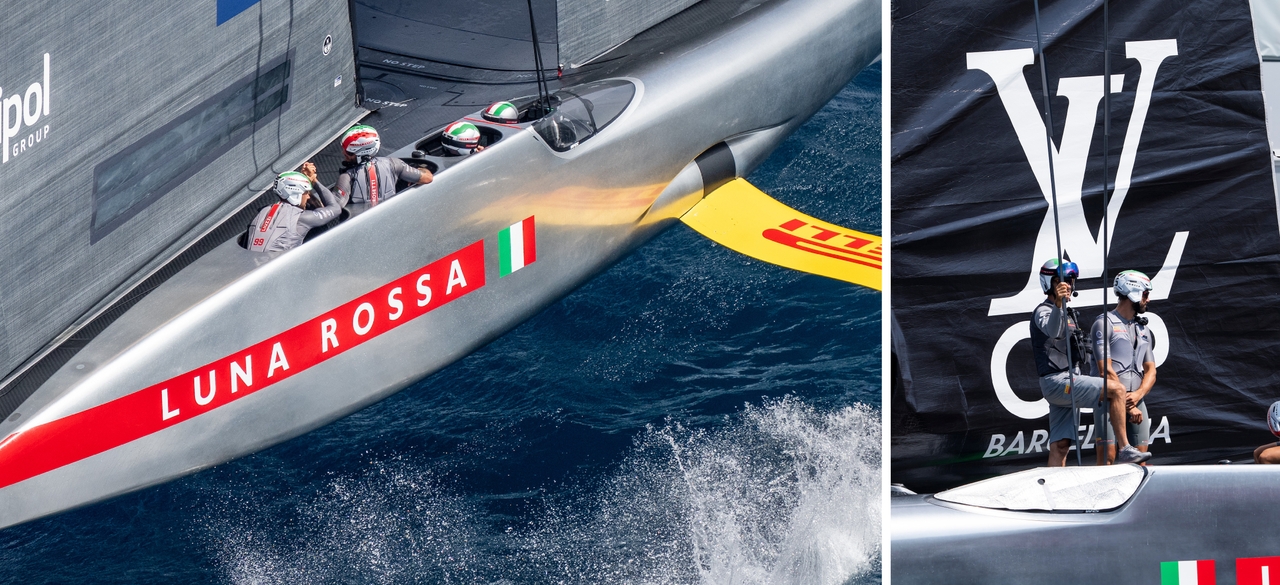
Luna Rossa Prada Pirelli made it to the Louis Vuitton Cup Final at the Louis Vuitton 37th America’s Cup but were dispatched by the highly technical INEOS Britannia team after a hard-fought series, 7-4, in some of the most memorable races that summer in Barcelona. Photos: © Ian Roman / America's Cup.
The challenge by Luna Rossa for the Louis Vuitton 38th America’s Cup in Naples is a mighty one. The team started training early in 2025 and took delivery of a second AC40 to conduct two-boat match-racing practice. Can they win in 2027 in their home country? They are the early favourites. Italy is set to go America’s Cup crazy and the ‘tifosi’ will be cheering from every vantage point of the picturesque Bay of Naples.
by Magnus Wheatley

The Louis Vuitton 38th America's Cup, Naples 2027
For the first time ever the Louis Vuitton Cup and Louis Vuitton America’s Cup Match will be sailed in Italy, a country with one of the most colourful and enthusiastic America’s Cup histories.
In 2027, the world will look to Italy and specifically to Naples, the capital of the Campania region in Italy, a UNESCO World Heritage Site and one of the most ancient cities in Europe, as it becomes the Host City for the world’s oldest international sports trophy.
The fight for the Louis Vuitton 38th America’s Cup will take place under the watchful shadow of Mt Vesuvius and just off the waterfront of the vibrant city. With a proud heritage and rich history, Italy and Naples offer the Louis Vuitton 38th America’s Cup an unparalleled experience that one way or another is certain to add to the myth, obsession, rivalry and innovation of the America’s Cup.
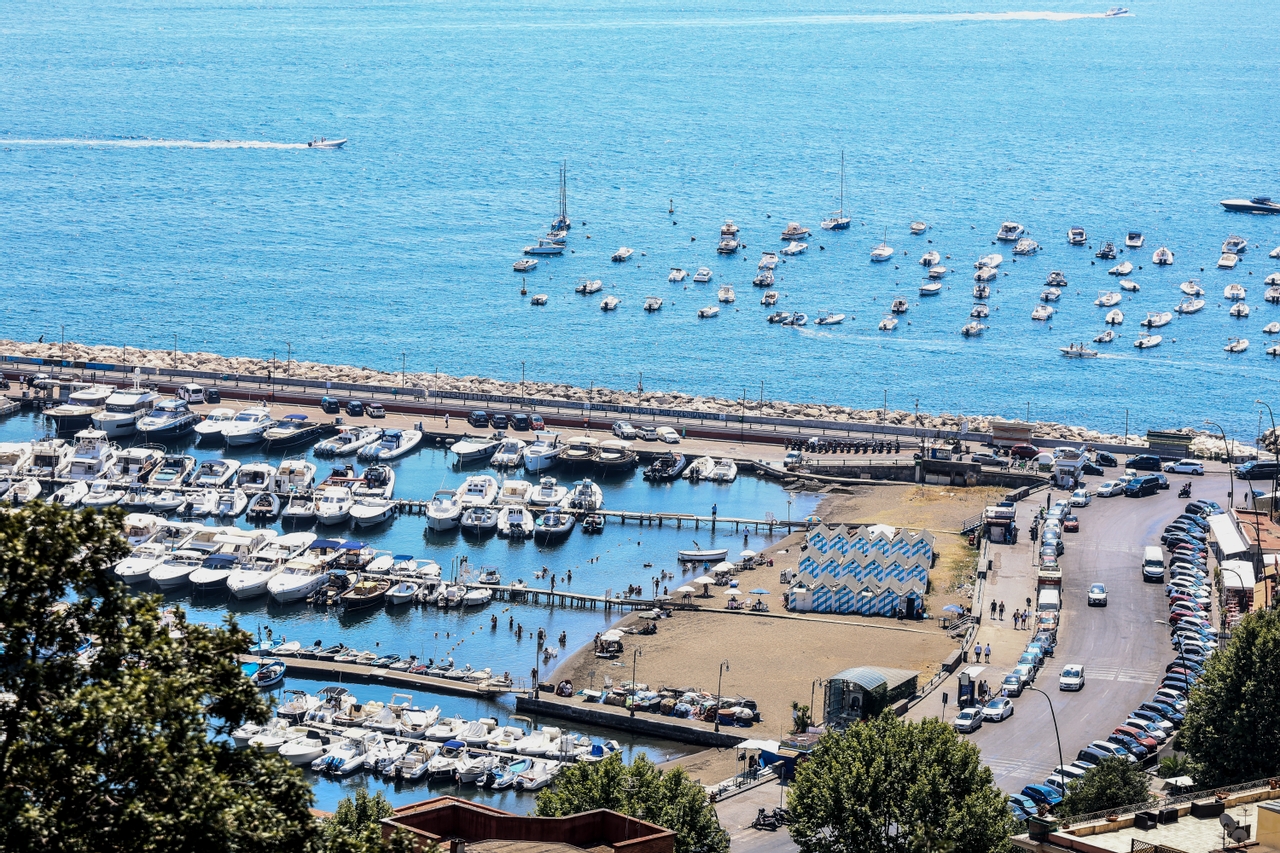
The beautiful city of Naples is all set to host the Louis Vuitton 38th America’s Cup and welcome the world. Photo: © Stefano Albamonte / Comune di Napoli / America’s Cup